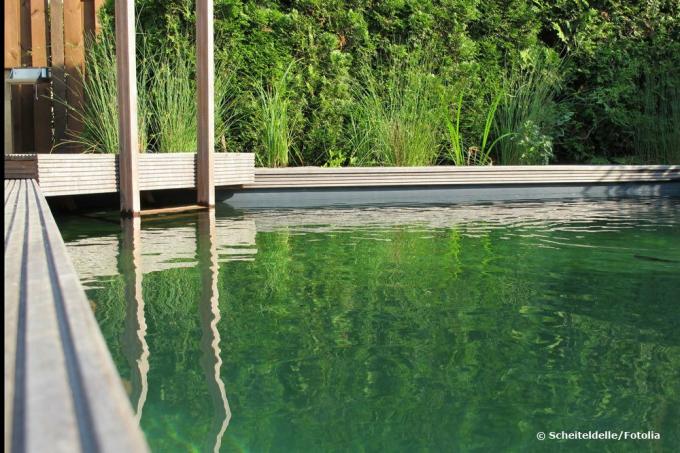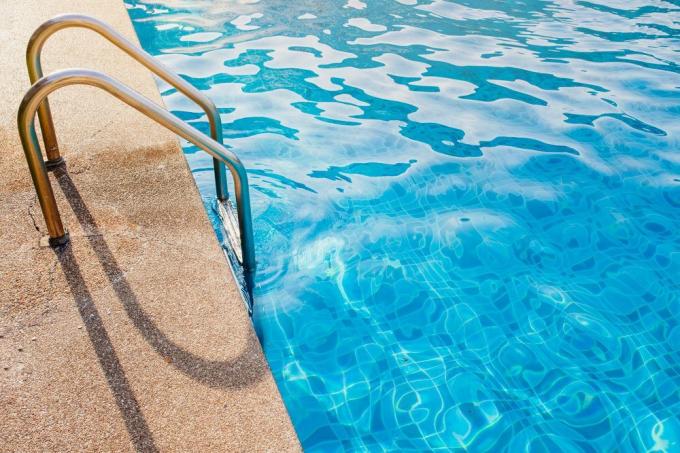
table of contents
- Chlorine in the pool
- Alternatives to chlorine in the pool
- Active oxygen
- bromine
- PHBM - Polyhhexamethylene biguanide
- ozone
- Salt water electrolysis - the middle ground
- Nature instead of chemistry
No matter whether in your own pool or in the public swimming pool: Those who like to bathe know the sometimes pungent smell, as well as the burning and reddened eyes. The reason for all of these things is chlorine in the pool. Usually barely noticeable, under certain conditions it can have a negative appearance and thoroughly spoil the fun of the water. Pool owners are therefore more and more often looking for alternatives without the need for enormous effort in pool maintenance and cleaning. We reveal how the pool works with alternatives without chlorine.
Chlorine in the pool
In order to be able to make a decision about sensible alternatives without chlorine for the pool, one should First of all, the task of this substance, which was previously hailed as a miracle cure, in the pool visualize. On the basis of the range of tasks performed, it can then be weighed up which method or which substitute will produce comparable results. These main tasks are performed by chlorine preparations:
- Binding of foreign substances such as fat, protein, urine, etc.
- Killing germs for a reduced likelihood of disease transmission
- Prevention of Algae growth to maintain a stable water quality
Attention: Water treatment with chlorine only works reliably and effectively in the medium pH range between 7.0 and 7.4. In addition to adding the actual chemical, the necessary pH value raisers and lowerers can also pollute the water and affect the body of the bathers.
Alternatives to chlorine in the pool
Adequate alternatives for chlorine should be able to fulfill the tasks described in the same way or at least to a comparable extent. Otherwise, the comfort achieved through the use of chlorine decreases in terms of the frequency and effort of cleaning and water replacement. Overall, the need for labor-intensive and cost-intensive pool maintenance is increasing significantly.
As a result, only a few real alternatives for a pool without chlorine have established themselves.
Note: In addition to the main task of replacing the function of chlorination, replacement methods must also be used Of course, it should also be compatible with the bathing people and just as uncritical in handling and disposal prove. These additional requirements further limit the number of possible products.
Active oxygen
A chemical alternative to chlorine is active oxygen, often known as hydrogen peroxide. The hydroxyl radicals released in the substance effectively kill germs and bacteria of all kinds during the Active oxygen itself as part of the reaction to water and oxygen - two completely uncritical end products - disintegrates. In use, the active oxygen is just as uncomplicated as the one to be replaced Chlorine products, however, the pool technology must be checked for suitability with hydrogen peroxide will.
Processing forms
- Tablets
- granules
- liquid solution
advantages
- high effectiveness against bacteria and other pathogens
- harmless end products, disposal therefore unproblematic
disadvantage
- Effective only at water temperatures below 25 ° C
- no binding effect with foreign substances
- no algicidal effect
- therefore mostly used in combination with algicides and flocculants
Note: Active oxygen works particularly well when exposed to UV radiation, so a combination of hydrogen peroxide and a UV system is worthwhile. The UV system required for this essentially corresponds to the UV ozone generator described below, but as a merely supporting device in a technically simple form.
bromine
The chemical element is only one place in the periodic table next to chlorine and is also very similar in its disinfecting effect. However, it has a far less strong oxidizing effect, so pool maintenance with bromine alone is hardly possible. As a rule, a combination of bromine and chlorine preparations is therefore used so that the Significantly reduce chlorine consumption, but still bind foreign matter and kill algae with its use can be achieved. Well adjusted, the combination therefore represents optimal cleaning with minimal use of chlorine.
Processing forms
- Tablets
- granules
- as a solution
advantages
- evaporates much more slowly than chlorine solutions, so it can also be used at higher water temperatures
- No formation of disadvantageous chloramines, therefore hardly any eye or skin irritation, and no odor formation
disadvantage
- no complete substitute for chlorine, overall only useful as a combination solution
PHBM - Polyhhexamethylene biguanide
Another alternative to chlorine is polyhhexamethylene biguanide. What sounds like a tongue twister to chemists in its long form is better under the abbreviation Biguanide or the trade-related Baquacil known. It is a completely chlorine-free chemical element with a very good disinfecting effect. The negative effects of chloramines, including stinging eyes and a pungent odor, are therefore excluded.
Processing forms
- Tablets
- granules
advantages
- no adverse effects on skin, eyes or pool linings
- no need to dissolve before adding to the water in the pool
- Long-lasting disinfectant effect, therefore adding at large intervals, usually weekly, is sufficient
- flexible in terms of pH and temperature of the water
- very UV-stable, therefore not influenced by intensive solar radiation
disadvantage
- no oxidizing effect, therefore ineffective against organic substances such as protein or urine
- no effective algae protection, therefore a separate algicide required
- No compatibility with bromine, active oxygen or chlorine, therefore shock chlorination is not possible
ozone
Similar to the protective effect of the ozone layer against the harmful effects of space, ozone is also in the Capable of killing germs and decomposing organic contaminants for pool maintenance to contribute. The ozone generators required for this type of cleaning work with two different methods to form the helpful ozone in the water:
- UV ozone generators use UV radiation to reliably kill pathogens.
- Corona discharge generators apply the so-called corona treatment and use an electric arc to achieve the germicidal effect.
Processing forms
- Technical systems, so-called ozone generators
advantages
- No recurring addition of chemicals required
- Effectiveness independent of the pH value
- Completely chlorine-free pool maintenance
disadvantage
- High acquisition costs for the technical equipment of the system
- Low effectiveness in humid climatic conditions
Salt water electrolysis - the middle ground
Admittedly, salt water electrolysis is not really one of the real alternatives for chlorine. Because after adding salt to the pool, the electrolysis system uses electrical energy to create inorganic active chlorine from the added salt. Contrary to the conventional Application of chlorine the effectiveness is significantly higher here, as the substance is produced on demand and does not require intermediate storage. There is also no need to buy, use or dispose of any items and can thus significantly reduce the risks associated with the use of chlorine. In addition, the higher effectiveness leads to a lower requirement overall, so that the burden on people and the pool is reduced. The only drawback of this process is the required salt content, which, at 0.3 to 0.5 percent, is hardly noticeable.
Processing forms
- Electrical system for electrolysis
- Salt as a powder or tablets
advantages
- Less chlorine requirement
- Lower risk potential
- Very cheap to maintain
disadvantage
- Not a real alternative to chlorine
Nature instead of chemistry
Finally, as a supplement to the chemical alternatives explained, the natural Pool water purification be briefly touched upon. Hardly feasible for quick-build pools or generally small-sized swimming pools, but a swimming pond can be an interesting variant if it is permanently established in a spacious garden. In place of the chemicals, there are aquatic plants, which take on the cleaning and sometimes even disinfecting effect. However, even such pool alternatives can hardly do without a mechanical filter system and a circulation.
The water temperature must also not rise too high in order to prevent bacteria and algae from offering favorable growth conditions. With natural swimming ponds, it is important to plan consistently with all components coordinated to form a coherent system. A “just like that” conversion from pool to swimming pond is therefore hardly successful in the long term and therefore not a sensible solution for carefree bathing without chlorine.




